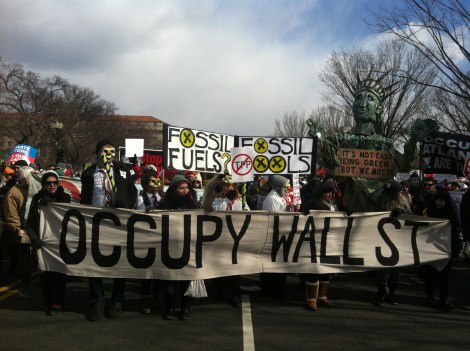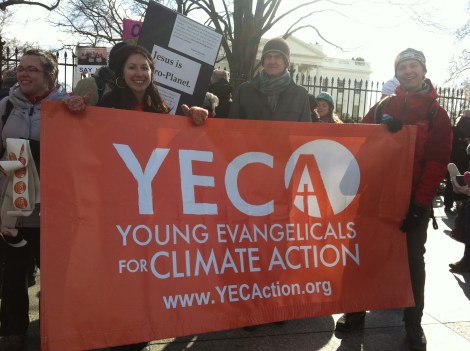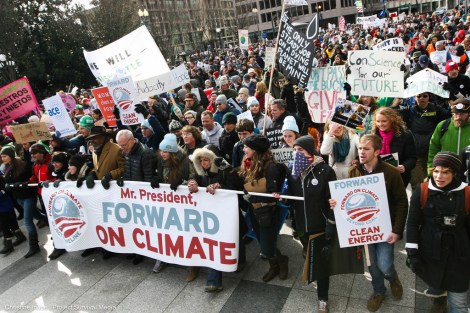Organizers called it the largest climate rally in U.S. history, and it was. Depending on who you ask, there were 30,000, 40,000, even 50,000 people in Washington, D.C., Sunday to lobby for political action on climate change. Depending on who you ask, the tone was joyous or righteous. And depending on who you ask, those 30,000, 40,000, even 50,000 people were giving President Obama an angry demand, a stern but friendly prodding, or the “support he needs” to take action.
350.org, the Sierra Club, the Hip Hop Caucus, and a comprehensive list of basically anyone in the U.S. who cares about climate change joined with politicians, investors, indigenous peoples, and an assortment of celebrities (can’t have a climate rally without some celebs!) to rally and lead a march on the White House Sunday afternoon, calling for an end to politics and policies that are cooking our planet to death. For all the serious stuff, it was also a party — chants for justice were mixed in with mini dance parties to pop music. But for all the Gangnam Style, there was an overwhelming sense that, while this rally was a glorious show, it was also indicative of just how bad things have gotten.
“We have a very entrenched system that’s going to really require us to work together for a vision of people, peace, and the planet,” the Green Party’s Jill Stein said in an interview. “We are here for the long haul.”
From fracking and coal to factory farming, activists called for an end to all the little things that are adding up to climate meltdown. But mainly today we were here because of the Keystone XL pipeline — the long-embattled project to pump vast quantities of tar-sands oil from Alberta to the Gulf of Mexico, halted a year ago by President Obama and up for a final decision this spring.
“This president has lifted the hope for the world with his inaugural address, with his State of the Union address. He cannot turn around in two weeks and crush the hopes of the world and his base and the next generation and the children of all species by letting a very dumb and dangerous project go through our country,” Rebuild the Dream’s Van Jones, former green jobs adviser to President Obama, told me. “I think it is up to us to make sure that he does not accept the pipeline. I don’t have any reason to believe at this point that the pipeline won’t go through.”
350.org’s Bill McKibben kicked off the rally in the early afternoon, listing some of the many (many!) different battles being waged nationwide in the war on climate change. “You are the antibodies kicking in as the planet tries to fight its fever,” McKibben said as a Park Police helicopter circled low and slow overhead. “And we have waited a looong time to get started.”
At first glance, it seemed a united front of climate activism, a relatively diverse and good-spirited crowd coming together to make change. It was indeed a broad coalition, but there were definite blocs within the group. Stein told me she wanted to speak at the rally but hadn’t been allowed to, for political reasons. “Fighting climate change” seemed to take on different meanings for different people: Was it marching in a permitted protest through the streets, blockading pipeline construction, or a more extreme escalation?
Within a span of five minutes while paused in front of the White House, I heard a soft rendition of “Down by the Riverside” and a rousing chant of “a-anti-anticapitalista.” Some dressed as polar bears while others wore black bandanas over their faces. Some signs asked nicely; others screamed.

As those tens of thousands circled the White House, President Obama was playing golf in sunny (warmer every day!) Florida with Tiger Woods. By the time the afternoon rolled around and the icy wind picked up, the crowd dispersed (but not until after a rousing round dance led by First Nations peoples from the Idle No More movement).
In all, the rally seemed to mark the end of the beginning of the new environmental movement. But the thing’s gotten so big, it seems to be having a bit of an identity crisis — torn between mainstream and radical aspirations.

In some ways, Sunday’s event was an absolutely historic response to a historic moment. And in some ways, it was exactly the same as these things always have been.
We come, we chant, we go home. So: What’s next?




